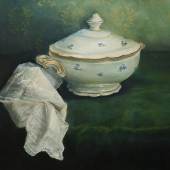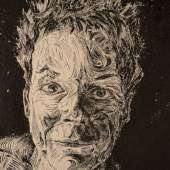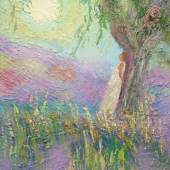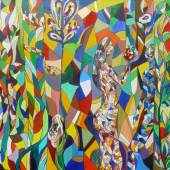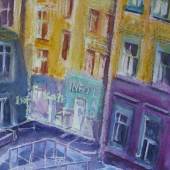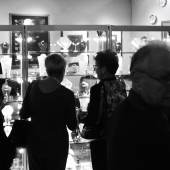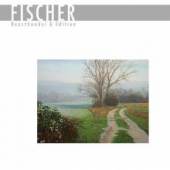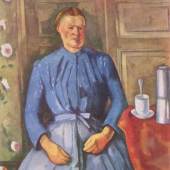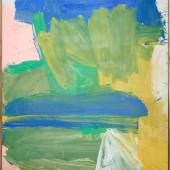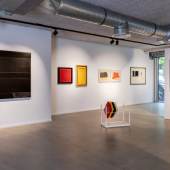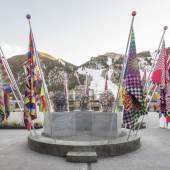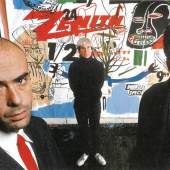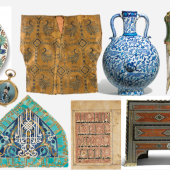Arts of the Islamic World 25 April 2018, Sotheby’s London
-
Ausstellung25.04.2018
ARTS OF THE QUR’AN
A carved jade and gilt metal Qur’an stand, India, circa 19th century (est. £4,000-6,000)
Qur’an stands worked from jade and other hardstones are extremely rare, with many examples held in museum collections. Designed to hold large Qur’ans, the legs are designed as lobed archways reminiscent of Mughal architecture.

A rare and finely decorated Qur’an leaf in eastern Kufic script, Persia or Central Asia, circa 1075- 1125 AD (est. £220,000-280,000) This extremely rare folio is an example of one of the most striking and beautiful Qur'anic scripts, originating from a Qur'an of majestic elegance and breath-taking graphic power. The floral decoration of the background of the entire text area throughout the manuscript marks it out as one of the most luxuriously decorated Qur'ans of the medieval period. The calligraphic display is characterised by acute angularity and an almost ethereal attenuation – combining elegance, energy, originality and immensely skilful execution. The original manuscript was produced in thirty volumes, each containing around seventy-five leaves, giving a total of approximately 2,250 leaves. Other leaves from this dispersed Qur'an are held in the collections of museums worldwide including The Metropolitan Museum of Art, New York, Topkapi Saray Library, Istanbul, the Aga Khan Museum Collection and the Cleveland Museum of Art.
An illuminated Qur’an juz, attributable to the scribe ‘Ali ibn Muhammad al- Muktib al-Ashrafi, probably illuminated by Ibrahim al-Amidi, Egypt, Mamluk, circa 1370-75 AD (est. £80,000-120,000) This lavishly-illuminated juz comes from an important Qur’an commissioned by
Sultan Sha’ban (r.1363-76) and was endowed to the Ashrafiyyah foundation
– with its other sections now the British Library, Chester Beatty Library and Tareq
Rajab Museum. With an elegant and fine style, it is an example of the apex of Mamluk Qur’an production in Cairo in the second half of the fourteenth century.
WHEN SILK WAS GOLD: RARE SOGDIAN GARMENT
An exceptional silk samite shirt with ducks, Central Asia, Sogdiana, 7th-9th century (est. £300,000- 500,000) In superb condition, this magnificent shirt, characterised by its rich honey-gold ground offset with designs in shades of blue, would have been considered a true ‘cloth of gold’ –prized by the Sogdian elite and its neighbours. An indicator of wealth and rank, this shirt would have served an important function in the context of trade and diplomacy. Today, it provides a rare glimpse into an important civilization that left an imprint on empires spreading over multiple continents and for many subsequent centuries.

Set within the mountainous plains comprising modern-day Uzbekistan and Tajikistan, the Sogdian Empire was at the centre of an extensive trade network of musk, silverware and silk. The best silks came from China, and the Sogdians, lying at the centre of various crossroads, not only developed routes along the Silk Road but also with the Persian market – hence the strong influence of Iranian motifs in the design. Adorned with facing ducks each wearing a flowing scarf and holding a pearl necklace, the remarkable condition of the shirt one thousand years later is testament to the use of the highest quality silk. It is one of very few examples in this state of preservation to exist, with notable examples held in international museums.
-
05.10.2019 - 13.10.2019Am 5. Oktober rollt die FAIR FOR ART Vienna der Kunst zum dritten Mal den roten Teppich aus. Mehr...
-
Fischer Kunsthandel und Edition wurde 1992 von Werner Fischer in Berlin gegründet. Seit 1998 ist...
-
Wo Sie die Werke Cézannes besichtigen können: Musée d’Orsay, Paris...
-
16.04.2024 - 15.09.2024Two stays in Italy inspired Willem de Kooning to bold experiments in his art, a new exhibition in...
-
17.04.2024 - 17.05.2024Marking 50 years of Sotheby's in the Belgian capital, an esoteric selling exhibition is on...
-
20.04.2024 - 24.11.2024Jeffrey Gibson on Representing the United States and Himself By Melissa Smith | Feb 16, 2024 From...
-
13.05.2024 - 15.05.2024Sotheby’s Sealed is thrilled to present this spectacular Mercedes-Benz 300 SL Alloy...
-
14.05.2024Warhol & Basquiat’s Collaboration Series Masterwork To Highlight Sotheby’s...
-
25.04.2018
.
